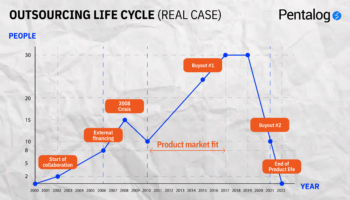What is IT Outsourcing? Definition, pros & cons, collaboration models, examples of solutions and services you can access, locations to consider and what to ask a provider.
IT outsourcing is the process of outsourcing certain Information Technology-related services and functions to an external service provider. It is a popular business model for companies of all sizes, allowing them to outsource the IT services they need on an as-needed basis, instead of hiring and managing their own IT staff.
In this article, we will look at what IT outsourcing is, its pros and cons, types and collaboration models, solutions and services you can access, and what to ask a provider.
What is IT Outsourcing and what does it mean for a business?
IT outsourcing involves using external service providers to deliver IT solutions in order to achieve business outcomes. This could be in the form of IT-enabled business process, application service or infrastructure solutions.
In a world where tech companies are looking for ways to enable digital transformation and accelerate backlog delivery, the advantages of integrating IT outsourcing resource can give you big gains over the short and the long-term.
By outsourcing their IT services, businesses can benefit from increased efficiency and cost savings, while still getting the expertise they need.
What are the benefits of IT outsourcing and why is it used by tech companies around the world?
One of the main reasons why companies are looking to outsource IT is as a means of tech support for their in-house team or to fill certain tech skills gaps. Outsourced IT services give CTOs and CIOs access to top engineering and digital talent around the world, usually at a lower cost and much faster than ramping up a team of full-time employees.
IT outsourcing enables enhanced speed of project delivery without the need for lengthy and costly recruitment processes. Organizations and their tech leaders who utilize IT outsourcing to meet specific IT needs also gain precious time back to focus on innovation and growth and fulfilling their business strategy.
There are multiple advantages of adding external expertise, including:
-
1. Cost savings: Outsourcing IT services can be cost-effective as businesses can avoid the costs associated with hiring, training, and retaining full-time employees. Outsourcing also enables businesses to pay only for the services they need, reducing unnecessary expenses and achieving economies of scale.
2. Access to specialized expertise: IT outsourcing allows businesses to access global talent with specialized expertise that may not be available in-house. This enables them to leverage the knowledge and experience of professionals who have specific skills and expertise in the area of IT.
3. Increased focus on core business functions: IT outsourcing frees up resources and allows businesses to focus on their core competencies. This can lead to increased efficiency and productivity.
4. Scalability: IT outsourcing services can be flexible and scalable, allowing businesses to adjust their IT resources and services as their needs change over time.
5. Improved service quality: IT outsourcing vendors often have specialized tools and processes in place to ensure high-quality service delivery. This can lead to improved performance, reliability, and security for businesses.
6. Reduced risk: Outsourcing IT functions can reduce the risk associated with managing complex IT systems. Providers often have robust security measures and disaster recovery plans in place, as well as intellectual property protection policies which can help businesses minimize the risk of data loss or other disruptions.
Overall, outsourcing IT services can provide several benefits to businesses, including cost savings, access to specialized expertise, increased focus on core business functions, scalability, improved service quality, and reduced risk.
What are the 4 main types of IT outsourcing?
Depending on the geographic proximity to the exeternal team, as well as the number of outsourcing vendors onboarded, there are four main types of IT outsourcing commonly agreed upon.
Nearshore outsourcing (nearshoring)
Nearshore outsourcing or nearshoring involves the transfer of IT services to a third-party provider in a neighboring or nearby country. This type of outsourcing is often chosen for similar reasons as onshore outsourcing, such as cultural affinity, language similarity, and similar time zones.
Offshore outsourcing (offshoring)
Offshore outsourcing or offshoring involves the transfer of IT services to a third-party provider in a different country. This type of outsourcing is often chosen for cost savings and access to a wider pool of skilled labor.
Onshore outsourcing (onshoring)
Onshore outsourcing or onshoring involves the transfer of IT services to a third-party provider within the same country. This type of outsourcing is often chosen when businesses want to maintain a similar cultural and language environment, and may provide better control over the outsourced work.
Multisourcing
Multisourcing refers to the practice of outsourcing different components of a business process or IT function to multiple third-party service providers, rather than relying on a single provider. Multisourcing is used to gain access to a broader range of skills and expertise, reduce dependency on a single provider, and improve service quality by leveraging the strengths of different providers. It also enables businesses to spread their risks by diversifying their outsourcing relationships.
What types of tech services can be outsourced to an external provider?
There are various types of tech services that can be outsourced to an external vendor, including:
-
1. Software engineering: This includes software development, architecture design, DevOps, application maintenance, QA testing, and debugging.
2. Product design and management: This includes UX/UI design, product framing, user behavior analysis, product ownership and more.
3. Infrastructure management: This includes managing servers, storage, networks, and databases.
4. Technical support and help desk services: This includes providing technical support to end-users, such as troubleshooting issues with software, hardware, and network connectivity.
5. Cybersecurity and data protection: This includes managing network security, managing data storage, conducting vulnerability assessments, and providing threat detection and incident response services.
6. Cloud computing services: This includes providing cloud-based infrastructure, software, and platform services, such as Infrastructure-as-a-Service (IaaS), Platform-as-a-Service (PaaS), and Software-as-a-Service (SaaS).
7. Digital marketing and advertising: This includes digital marketing campaigns, social media management, search engine optimization, and pay-per-click advertising.
8. Data analytics and business intelligence: This includes collecting, analyzing, and interpreting data to help businesses make informed decisions and improve their operations.
9. Internet of Things (IoT) services: This includes managing and analyzing data from connected devices, such as sensors and smart devices.
What collaboration models are available when outsourcing IT projects?
There are several IT outsourcing collaboration models that businesses can use to work with third-party service providers. Some of the most common models include:
Extended teams: a staff augmentation model
In an extended team or staff augmentation model, the third-party service provider provides additional qualified staff to work with the business’s existing employees. The outsourced team acts as an extension of the customer’s in-house team and is commonly used to fill gaps in technical skills or capacity, or to support shorter-term projects. In such an organization, the customer remains firmly in control of the software development process, including workflow, as well as the organization of the team, the tools and project methodology.
Managed teams: a dedicated team model
Also refered to as managed team, the dedicated team model is a popular outsourcing option for companies looking for a flexible, cost-effective way to complete complex, long-term projects. The advantage of the dedicated team model is that it provides businesses with access to a group of professionals who are solely dedicated to their project or service. Following the Agile methodology, dedicated or managed teams have their own governance models, which ensure regular customer engagement, while giving the team the autonomy to speed backlog delivery and ensure faster go-to-market for the customer’s product or service.
Managed services
In this model, the third-party service provider takes full responsibility for the management and delivery of a specific IT function or set of functions. This can include everything from infrastructure management, network and equipment monitoring and maintenance to cloud support.
These are just the top three most commonly used IT outsourcing collaboration models, Choosing the right one for your business will depend on a range of factors, including the company’s goals, the complexity of the IT function being outsourced, and the level of control and involvement you wish to maintain.
What pricing models can companies expect from an outsourcer?
There are several pricing models commonly used in IT outsourcing, including:
-
1. Time and materials: In this model, the client pays for the actual time and materials used by the outsourcing provider. The provider invoices the client for the actual hours worked by its team and the materials used for the project. This model is commonly used for Agile projects, when software delivery is incremental and the scope of the project adapts as the business strategy evolves.
2. Fixed price: In this model, the outsourcing provider agrees to deliver a specific set of services or project for a fixed price. This model is used when the scope of the project is well defined, and the provider has a clear understanding of the work involved.
3. Cost-plus: In this model, the outsourcing provider is paid for the actual cost of the project plus a percentage of profit. This model is used when the scope of the project is not well defined, and there is a risk of unexpected costs.
4. Outcome-based: In this model, the outsourcing provider is paid based on the results achieved or the value delivered. This model is used when the project’s success is linked to specific outcomes, such as increased revenue, improved customer satisfaction, or reduced costs.
5. Retainer: In this model, the client pays a fixed monthly fee to the outsourcing provider to provide ongoing IT support or application maintenance services.
The choice of pricing model will depend on several factors, including the project’s scope, complexity, and the level of risk involved. It is important to choose a pricing model that aligns with the project’s objectives, and that provides transparency and accountability throughout the project lifecycle.
Where can you find the best outsourced IT talent?
IT outsourcing has become a popular business strategy for companies looking to reduce costs, access specialized skills, and improve efficiency. Here are some of the most popular IT outsourcing locations:
-
1. Eastern Europe: Eastern Europe is becoming increasingly popular as an IT outsourcing location due to its skilled workforce, very few culturall differences to Western Europe, and lower costs compared to other European countries. Countries such as Romania, Moldova, Poland, Ukraine and Bulgaria are emerging as top IT outsourcing destinations in this region, giving access to expert skills in software development, artificial intelligence and cybersecurity.
2. Latin America: Latin America is emerging as a popular IT outsourcing location due to its cultural similarity to the United States, a large pool of skilled professionals, and lower labor costs. Countries such as Mexico, Brazil, and Argentina are gaining popularity as IT outsourcing destinations in this region.
3. North Africa: Companies are turning their attention to this region, considering countries such as Morocco or Tunisia as good outsourcing options for many reasons, including skill diversity, lower cost of labor, as well as business-friendly government policies. The region has easy access to major markets and transportation hubs, making it easier to coordinate with clients and partners.
4. Asia: Chosen in many cases for cost optimization reasons, countries such as India, Vietnam, China or the Philipinnes are popular IT outsourcing locations due to the variety of skills they give access to, such as niche software development stacks, artificial intelligence, data analytics or cypersecurity. Also, the favorable business environment figures among the main reasons why they have become outsourcing hotspots.
These are some of the most popular IT outsourcing locations, but there are many other countries and regions that also offer skilled IT professionals, lower costs, and a favorable business environment for outsourcing.
What to look for when outsourcing to an external vendor?
While entrusting product development to an IT outsourcing company can help to overcome resource inadequacies, there are challenges of outsourcing. For example, finding a long-term partner that ticks all the right boxes when it comes to software quality, development costs and ease of collaboration.
First and foremost, it’s important to determine the reasons you need IT outsourcing, and then continue your search from there. Many organizations start by outsourcing their IT Software Maintenance while others focus on whether a nearshore or offshore outsourcing location would suit their needs and budget best.
When working with an IT outsourcing vendor, it’s important to look for certain key factors to ensure a successful partnership. Here are some things to consider when choosing an IT outsourcing vendor:
-
1. Expertise: Look for a vendor that has the expertise and experience to meet your specific needs. Consider their track record and client references, as well as their ability to provide solutions in areas such as software development, cloud computing, cybersecurity, and data analytics.
2. Communication: Clear communication is critical to the success of any outsourcing project. Look for a vendor that has strong communication skills and is willing to establish clear lines of communication, such as regular status updates and project reports.
3. Quality: Quality should be a top priority when selecting an IT outsourcing vendor. Ensure that they have a robust quality assurance process in place and are committed to delivering high-quality services that meet your expectations.
4. Flexibility: Look for a vendor that is flexible and can adapt to changing needs and requirements. They should be willing to work with you to develop a custom solution that meets your specific needs.
5. Cost-effectiveness: While cost is not the only factor to consider, it’s important to choose a vendor that offers a cost-effective solution that fits within your budget.
6. Security: With cyber threats on the rise, security is a critical consideration when choosing an IT outsourcing vendor. Ensure that they have robust security measures in place to protect your data and systems.
7. Cultural fit: Look for a vendor that has a cultural fit with your organization. They should be able to understand and work effectively within your organization’s culture and values.
To help you make an outsourcing analysis, here you will find articles on how IT outsourcing works, what to expect from your outsourcing partner, how to choose between multiple vendors, and how to successfully onboard an outsourced team to expand your in-house development team’s capacity.
To support your strategic decision-making, you will also find specific content comparing outsourcing models and contracts, exploring outsourcing locations and assessing the benefits of outsourcing development.
Whether you are new to the IT outsourcing arena or simply looking to expand your knowledge, you will find a wealth of IT outsourcing content to help you make informed decisions in future.





















